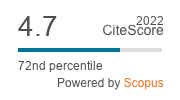The concern regarding toxicity from the presence of deoxynivalenol (DON) in wheat that affects both economy and public health leads to the need to find appropriate detection methods for determining the degree of DON contamination in terms of the equipment available and the speed required for obtaining the incidence. The objective of this study was to compare the performance of two alternative analytical techniques for DON quantification for use in the food industry with a reference technique. Samples of wheat and the commercial by-products were analysed by high-performance liquid chromatography (HPLC) with an ultraviolet detector as the reference method and the results compared with those obtained from a rapid lateral-flow immunochromatographic device (Reveal Q+) and of a Fourier-transform-infrared (FTIR) spectroscopy technique. Pearson’s correlation coefficient between the HPLC and Reveal-Q+ data (0.45), although significant (P<0.0003), was lower than that obtained between HPLC and the FTIR method (0.94, P<0.0001). Both methods were considered efficient in quantifying DON levels in wheat-flour samples. This study was aimed at assisting the producers in choosing an appropriate tool for the purpose of analysis and upon consideration of the available equipment.
RESEARCH ARTICLE
Analytical techniques for deoxynivalenol detection and quantification in wheat destined for the manufacture of commercial products
A. Astoreca Related information
1Centro de Investigación y Desarrollo en Fermentaciones Industriales (CINDEFI), CONICET-Facultad de Ciencia, Exactas, Universidad Nacional de La Plata, calle 47 y 115, B1900ASH La Plata, Argentina.
*astoreca@biotec.
#these authors contributed equally to this work
, L. Ortega Related information*astoreca@biotec.
#these authors contributed equally to this work
1Centro de Investigación y Desarrollo en Fermentaciones Industriales (CINDEFI), CONICET-Facultad de Ciencia, Exactas, Universidad Nacional de La Plata, calle 47 y 115, B1900ASH La Plata, Argentina.
#these authors contributed equally to this work
, C. Fígoli Related information#these authors contributed equally to this work
2CINDEFI, CONICET-Facultad de Ciencias Exactas, Universidad Nacional de La Plata, Laboratorio de Bioespectroscopía, calle 47 y 115, B1900ASH La Plata, Argentina.
, M. Cardós Related information3Molino Campodónico, calle 58 No. 331, B1900BPM La Plata, Argentina.
, L. Cavaglieri Related information4Departamento de Microbiología e Inmunología, Facultad de Ciencias Exactas, Físico Químicas y Naturales, Universidad Nacional de Río Cuarto, Ruta Nacional 36 Km 601, 5800 Río Cuarto, Córdoba, Argentina.
, A. Bosch Related information2CINDEFI, CONICET-Facultad de Ciencias Exactas, Universidad Nacional de La Plata, Laboratorio de Bioespectroscopía, calle 47 y 115, B1900ASH La Plata, Argentina.
, T. Alconada Related information1Centro de Investigación y Desarrollo en Fermentaciones Industriales (CINDEFI), CONICET-Facultad de Ciencia, Exactas, Universidad Nacional de La Plata, calle 47 y 115, B1900ASH La Plata, Argentina.
World Mycotoxin Journal: 10
(2)- Pages: 111 - 120
Published Online: December 23, 2016
Abstract
2023 Journal Impact Factor
2.0
source: Journal Impact Factor 2023™ from Clarivate™

Institutional Offers
For institutional orders, please contact [email protected].
Purchase Options
-
P. Battilani and M. Camardo Leggieri
-
F. Xu, R.C. Baker, T.B. Whitaker, H. Luo, Y. Zhao, A. Stevenson, C.J. Boesch and G. Zhang
-
A.O. Aasa, F.F. Fru, O.A. Adelusi, S.A. Oyeyinka and P.B. Njobeh
-
F. Wu
-
V. Ostry
-
V. Ostry
-
R. Bandyopadhyay, A. Ortega-Beltran, A. Akande, C. Mutegi, J. Atehnkeng, L. Kaptoge, A.L. Senghor, B.N. Adhikari and P.J. Cotty
-
A. Logrieco, A. Moretti and M. Solfrizzo
-
G. Schatzmayr and E. Streit
-
B. Grenier and I. Oswald



